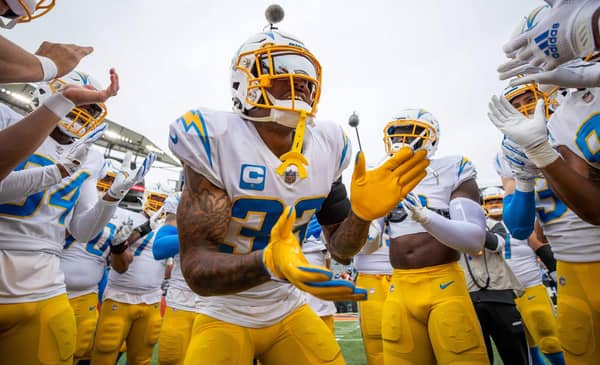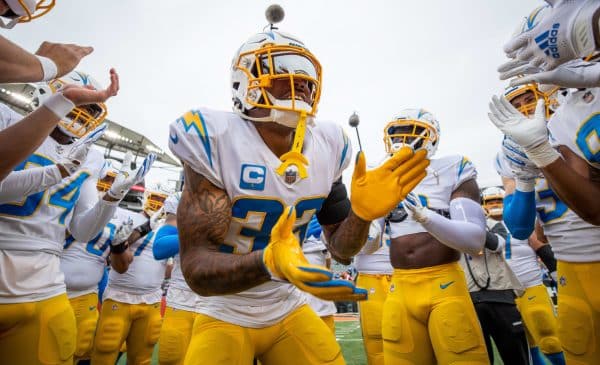
How The Chargers Can Build The Next Super Bowl Team
The end of the 2021 NFL season is upon us, unfortunately for all of us football junkies who eat, sleep, and breathe everything related to the sport. For teams that made the playoffs, and advanced in the playoffs, the sting is likely too fresh to really dive into all the offseason content. For the Los Angeles Chargers, who watched the playoffs on their couches, the offseason is in full swing.
With the week off in between the conference championships and the Super Bowl, many media pundits turn the conversation towards examining the team-building processes for both of the participants and looking at how they got there. The conversation around teams who are not participating in the big game is focused on how they can catch the teams that are. Recently, Chargers Head Coach Brandon Staley talked with Bally Sports’ Michael Silver about their season. Staley expressed his disappointment about the way the season unfolded, but also expressed a sentiment of optimism toward the future: “Because there’s that feeling of emptiness and that fire at the same time. You can’t look back. Everything’s about what’s in front of you. But to (watch the AFC championship game) and know that you beat both of those teams, I think it shows you, ‘Hey, we’re coming.’”
Today, I wanted to hone that in specifically to lessons the Chargers can take from both of these teams in order to ensure that they best take advantage of their current team-building window.
Lesson One: Support Your Stars
Each of the three teams in question has star players. Everyone knows that stars win championships. The Rams have Matthew Stafford, Aaron Donald, Jalen Ramsey, Cooper Kupp, Von Miller, and Andrew Whitworth. The Bengals have Joe Burrow, Ja’Marr Chase, Joe Mixon, Trey Hendrickson, Jessie Bates, and Tee Higgins. The Chargers have this box checked as well with Justin Herbert, Derwin James, Joey Bosa, Austin Ekeler, Rashawn Slater, and Corey Linsley. You can throw Keenan Allen and Mike Williams in that conversation too.
To me, the thing people miss about the Rams, in particular, is what they do to support their stars. Everyone wants to focus on the Rams trading for star players, but the way they support their stars is their greatest strength in my opinion. That is the biggest difference between them and the Chargers. That’s why they are playing in the big game this weekend, because of their depth.
This starts with Donald and the defensive line where the Rams have continually poured in resources to support arguably the best player in the sport. They of course had Michael Brockers already on the roster when they drafted Donald back in 2014. Most NFL teams (including the Chargers) would look at the pairing of Donald and Brockers as an excuse to skimp out on the depth at defensive tackle and fortify positions of need in other areas. That hasn’t stopped them from drafting Sebastian Joseph-Day, Morgan Fox, Greg Gaines, Tanzel Smart, John Franklin-Meyers, and most recently Bobby Brown. They have also gone out of their way to acquire A’Shawn Robinson and Ndamukong Suh.
The sample size around Ramsey is obviously smaller but the same principle applies. They’ve supported him by drafting Robert Rochell, Terrell Burgess, Jordan Fuller, Taylor Rapp, David Long, Nick Scott, and John Johnson in recent years. They’ve also acquired Darious Williams, Eric Weddle (twice), Troy Hill, Nickell Robey-Coleman, and Marcus Peters to play key roles alongside the best corner in the league.
That consistent effort to build up the depth around Donald and Ramsey has allowed the Rams to even go out and trade players like Brockers and Peters, not have the units around their best players be an absolute train wreck, and collect more assets around them. Imagine if the Chargers had good enough depth around Bosa or James to the point where they could’ve afforded to trade Melvin Ingram or Adrian Phillips instead of letting them walk for pennies on the dollar and get nothing in return? (The latter will always sting.)
Lesson Two: Continually Invest In Skill Positions
This is the first time the Bengals have played in the Super Bowl in over 30 years, and over that time they’ve been somewhat of a running joke. That being said, they’re here now and don’t appear to be going anywhere with such a great group of young players, including Chase, and that’s where this lesson will start.
If you’re familiar with me, you know that I was firmly on the side of the Penei Sewell vs Chase debate, but it is hard to argue with the results. Chase will wrap up the greatest rookie season in the history of rookie wide receivers on the biggest stage the NFL has to offer. Sewell was very good as a rookie on the Lions, but the Bengals would simply not be in this situation if they had chosen him over Chase back in April.
The investment in the skill positions is actually a core draft philosophy of the Bengals and it has been of great benefit to Burrow this year, as it was to Andy Dalton before him. The end of the Marvin Lewis/Dalton era was a bitter one, but they made it to the playoffs five straight years from 2011-2015 in large part due to the offense that they built around Dalton’s skill set.
We have 11 years of draft evidence since they took Dalton in the second round all those years ago. Over those 11 drafts, the Bengals have drafted 14 wide receivers including A.J. Green (same draft as Dalton), Mohamed Sanu and Marvin Jones, Tyler Boyd, Higgins, and most recently Chase. In fact, the only draft in which they didn’t draft a receiver was 2019. In that same time frame, they also drafted six tight ends and 11 running backs. Including Tyler Eifert, C.J. Uzomah, Giovani Bernard and Rex Burkhead, Jeremy Hill, Mixon, and Chris Evans.
That being said, of course, they have had some misses in that same time frame. Perhaps none worse than the selection of John Ross in 2017. The overall point here, though, is that they have taken a ton of bites at the apple and have generally been rewarded with strong skill player units because of it. Again, having a bonafide number one receiver in Green did not deter them from drafting Sanu and Jones the following year, or Boyd in 2016.
In contrast, in the nine drafts under Tom Telesco, the Chargers have only taken seven receivers: Allen, Tevin Reese, Williams, Dylan Cantrell, Joe Reed and K.J. Hill, and most recently Josh Palmer. Similarly, they have only drafted five running backs in that time frame: Marion Grice, Melvin Gordon, Justin Jackson, Joshua Kelley, and Larry Rountree. The pattern continues to the tight end position where they have only drafted two tight ends in nine years: Hunter Henry in 2016 and Tre McKitty in 2021. Contrary to the Bengals, the Chargers have not taken enough bites of the skill player apple and therefore, the misses stand out more egregiously. They have young players at each of these positions on the roster now, but that shouldn’t stop them from continuing to invest resources in players that will support their young demi-god quarterback over the next few drafts.
(Note: this obviously does not mean that I am advocating for the Chargers to neglect the offensive line like the Bengals have.)
[pickup_prop id=”18923″]
Lesson Three: Continue To Add Talent Throughout The Season
Telesco caught a lot of flack on social media at the trade deadline this year when he didn’t take a swing for a better right tackle or another defensive or offensive playmaker but they did successfully onboard Michael Schofield, Andre Roberts, and Dustin Hopkins during the season. For what it’s worth, we did hear that they poked around the pass-rusher market but ultimately no deal was made. Staley did also say that if they had been able to find a deal they liked, they would have made one.
Generally speaking though, Telesco has been resistant to the whole midseason acquisitions thing. He prefers to keep things in-house as much as he can. Hopefully, those three additions and the poking around from this year turn into a more aggressive in-season mentality going forward because the Rams and Bengals are not playing in the Super Bowl this weekend without the in-season acquisitions and play of Odell Beckam Jr, and B.J. Hill, respectively.
I can justify the Chargers not adding another offensive playmaker due to the play down the stretch of Palmer, McKitty, Jackson, and Jalen Guyton. Quality offensive tackles rarely hit the market in-season so there likely weren’t any deals available there, and Storm Norton did have some good moments in the middle of the season. However, there are always a bunch of defensive playmakers available for trade every year. Players like Miller, Ingram, Charles Omenihu, C.J. Henderson, Sidney Jones, and Shaq Lawson were all traded before this year’s deadline for example.
This offseason is going to be a real test for the Telesco/Staley marriage in terms of roster building. The defensive line was not good enough in 2021 and will be the focus, but that doesn’t mean you don’t invest in the secondary because you have James and (hopefully) a rising star in Asante Samuel Jr or in the skill positions because you have Allen, Williams (presumably), and Ekeler. If anything, the Rams and Bengals have proven that just because you have a player who can cover up your warts, doesn’t mean you should always ask them to do so. The good news for the Chargers going forward is that they have what I believe to be the right foundation. They have the core players and star talent necessary to be a contending-level team. They just need to tweak some things and be better at supporting those star players going forward, and I do think that they are trending in the right direction with Staley’s involvement in that regard.

Top Shots 2021: Best of Derwin James – Ty Nowell
